1940s
Funeral Traffic Control
1948: Chicago's Mt. Carmel cemetery sought FCC approval so that it could operate a two-way radio system to direct funeral processions, so as to avoid traffic jams in the cemetery.I wonder if they had to build a traffic control tower as well?

Freeport Journal-Standard - Apr 14, 1948
Posted By: Alex - Sat Oct 17, 2015 -
Comments (3)
Category: Death, Jobs and Occupations, 1940s
Idleness, Profligacy, and Dissipation

San Bernardino County Sun - Apr 29, 1949
LOS ANGELES, April 28 — After 64 years of marriage, Mrs. Calogera Cassaro, 85, has decided she wants a divorce.
She sued today for dissolution of her bonds to 86-year-old Sebastian Cassaro and restraining order to keep him from molesting or threatening her.
Sebastian, she stated in her complaint, is able-bodied and she wants him to support her, but she claims that of late he has been living "in idleness, profligacy and dissipation."
Posted By: Alex - Wed Oct 14, 2015 -
Comments (4)
Category: Divorce, 1940s
Wrong Date
Leroy Irwin, a 92-year-old farmer living in Allegan, Michigan, decided to have the dates of his life carved on his gravestone before he died, because (having no children) he wasn't sure who would pay to do it after he died.He carved the dates 1856-1950, but it turned out he was a little too optimistic. He died in November 1949, seven weeks shy of reaching 1950.

The Escanaba Daily Press - Apr 25, 1949

The Escanaba Daily Press - Nov 14, 1949
Update: To answer Patty's question (in the comments), the incorrect date wasn't changed. Leroy Irwin's grave (with the wrong date) remains standing in Hudson Corners Cemetery.

Image via Findagrave.com.
Posted By: Alex - Sat Oct 03, 2015 -
Comments (13)
Category: Death, 1940s
Where the heck am I?
1949: Street sweeper Joseph Pistolese, age 74, just keep sweeping until suddenly he looked up and realized he had no idea where he was.
Brooklyn Daily Eagle - July 27, 1949
After coming across the news clipping about Pistolese, I then noticed the birthday card below on sale at the supermarket. Since it reminded me of him, I had my wife snap a photo of it with her iPhone.
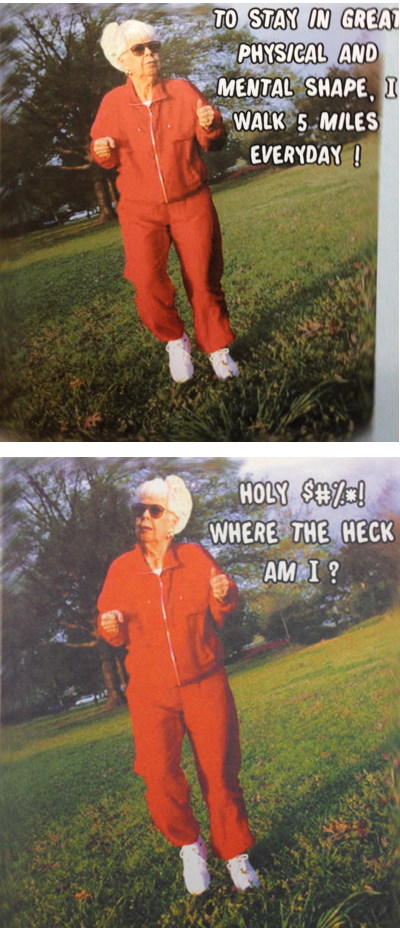
Posted By: Alex - Mon Sep 28, 2015 -
Comments (15)
Category: Elderly and Seniors, 1940s
Bond Clothing Sign, NYC

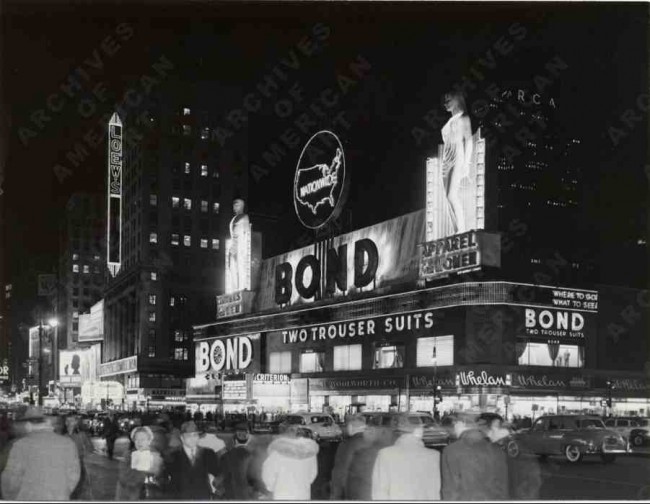
The Wikipedia entry tells us:
Between 1948 and 1954, Bond Clothes operated a massive sign on the east side block of Broadway between 44th and 45th streets in New York's Times Square. The sign had nearly 2 miles of neon and included two 7-story-tall nude figures, a man and a woman, as bookends. Between the nude figures, there was a 27-foot-high (8.2 m) and 132-foot-wide (40 m) waterfall with 50,000 gallons of recirculated water. Beneath the waterfall was a 278-foot-long (85 m) zipper sign with scrolling messages. The Bond zipper was made up of more than 20,000 light bulbs. Above the waterfall was a digital clock with the wording "Every Hour 3,490 People Buy at Bond."[7] Some of the sign remained in place to advertise the Bond Stores location until the stores closure in 1977.
Posted By: Paul - Mon Sep 28, 2015 -
Comments (3)
Category: Beauty, Ugliness and Other Aesthetic Issues, Signage, 1940s, 1950s
The Life Cycle of the Pin Mould
"If a ripe head is squeezed, an enormous number of little things fastened together in a sticky mess are jerked out."
They teach this filth in our schools!?!
Posted By: Paul - Tue Sep 22, 2015 -
Comments (3)
Category: Boredom, Hygiene, Innuendo, Double Entendres, Symbolism, Nudge-Nudge-Wink-Wink and Subliminal Messages, Nature, 1940s
MacLevy Leg Massager

Image source: Time magazine - April 19, 1948
Displayed at a Beauty Shop trade convention in Manhattan's Grand Central Palace, April 1948.
The machine (the MacLevy Leg Massager) was marketed to beauty shop owners. The introduction of home permanent wave kits in the mid-1940s had caused a steep decline in business for beauty shops, so the inventors of machines such as the leg massager were promising the shop owners that they could lure customers back by installing gadgets such as this, which would allow them to offer new services without having to hire trained masseuses.
The leg massager was invented by Monte MacLevy, who filed a patent application for it in July 1939. From the patent:

Posted By: Alex - Mon Sep 21, 2015 -
Comments (6)
Category: Inventions, Patents, 1940s
When the Circus Comes to Town
I have no idea of the provenance of this half-hour compilation. Shown at cinemas before the main feature? Whatever the case, it has everything. Cornball music, girly cheesecake, animated cartoon, stop-motion cartoon, narration by a chimp. Also, the highly disturbing image reproduced below. Somehow I feel it relates to the "horse fondling" theme of yesterday.
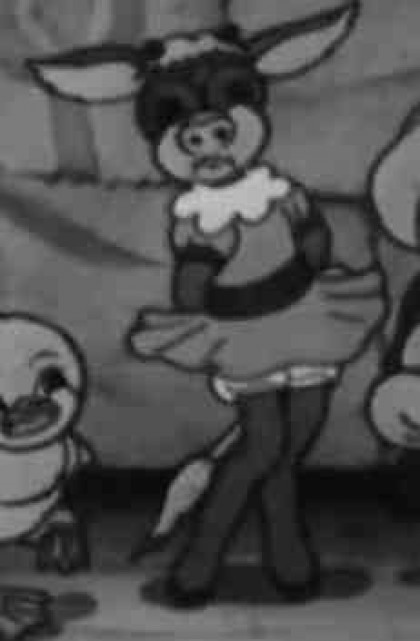
Posted By: Paul - Wed Sep 16, 2015 -
Comments (6)
Category: Animals, Clowns, Dreams and Nightmares, Music, Sex Symbols, Cartoons, Stop-motion Animation, 1940s
Selden the Stratosphere Man
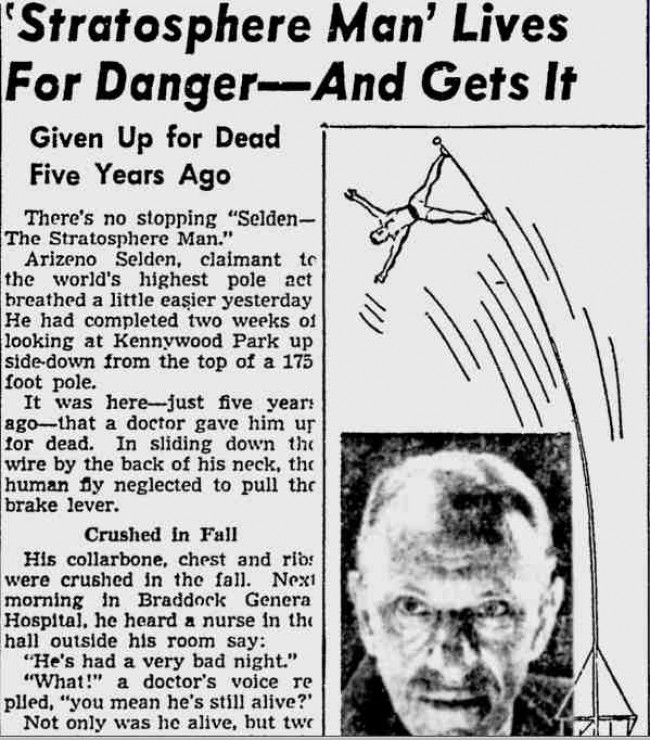



Original article here.

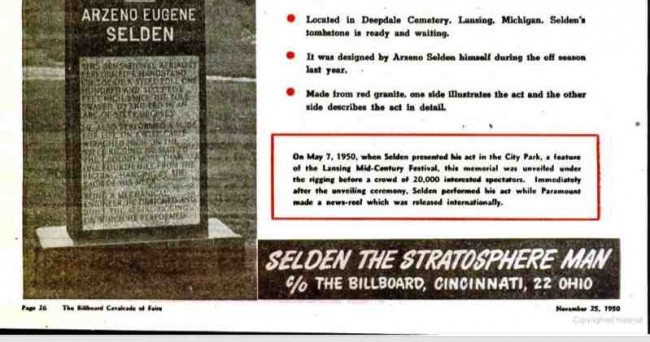
Original ad here.
Posted By: Paul - Sun Sep 06, 2015 -
Comments (3)
Category: Daredevils, Stuntpeople and Thrillseekers, 1940s, 1950s
Auroratone
Auroratone was a "process for translating music into color" invented circa 1940 by Englishman Cecil Stokes. The music vibrated an emulsion of crystallizing chemicals, and this was then photographed by a color movie camera, producing a kind of psychedelic movie of shifting colors synchronized with music (but this was the 1940s, before the concept of psychedelics was known in popular culture).The hope was that these auroratone films could be used to treat psychiatric patients, and they were experimentally shown to soldiers in an army hospital suffering from psychotic depressions. Conclusion: "Observation revealed that these patients were intensely absorbed in the films, that their span of attention to the films was appreciably lengthened after exposure to the films. Weeping and sobbing was observed in some patients. Many patients became more accessible to individual and group psychotherapy immediately folllowing exposure to these films."
Their effect was also tested on juvenile delinquents. One kid told the experimenter, "I think God must have painted those pictures."
A company was formed to commercialize Auroratones and guide their development. Investors in this company included the Crosby Brothers (Larry and his famous brother Bing). Bing sang the music for many of the auroratones.
Treating psychiatric patients wasn't very profitable, so there was hope to find more lucrative applications of the auroratone process. One idea was to transfer auroratone color patterns onto textiles and ceramics. Some silk scarfs printed with visualizations of Bing Crosby singing "Home on the Range" were apparently manufactured, but never sold.
Not many auroratones still survive, but an example of one can be viewed on YouTube:
The auroratone process reminds me of the Clavilux (or Color Organ) invented by Thomas Wilfred in 1919 (previously posted about here).
More info about auroratones: Wikipedia and Milwaukee Journal, Dec 6, 1948.
Also see: Rubin, HE & Katz, E. (Oct 1946). "Auroratone films for the treatment of psychotic depressions in an army general hospital," Journal of Clinical Psychology, 2(4): 333-340.
Posted By: Alex - Thu Sep 03, 2015 -
Comments (9)
Category: Movies, Photography and Photographers, Psychology, 1940s

| Who We Are |
|---|
| Alex Boese Alex is the creator and curator of the Museum of Hoaxes. He's also the author of various weird, non-fiction, science-themed books such as Elephants on Acid and Psychedelic Apes. Paul Di Filippo Paul has been paid to put weird ideas into fictional form for over thirty years, in his career as a noted science fiction writer. He has recently begun blogging on many curious topics with three fellow writers at The Inferior 4+1. Contact Us |




